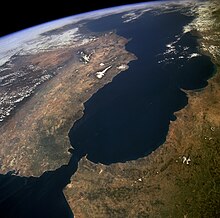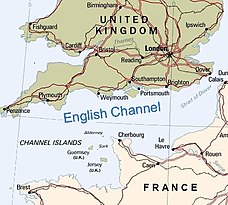Choke point
[citation needed] The Spanish treasure fleets leaving the Americas would have to pass through those waters to pick up the strong, prevailing westerly winds that would take them back to Spain across the North Atlantic.The GIUK gap is particularly important to the Royal Navy, as any attempt by northern European forces to break into the open Atlantic would have to do so through the heavily defended English Channel, which is also the world's busiest shipping lane, or through one of the exits on either side of Iceland.The GIUK gap was also a strategically important part of the Cold War, as the Royal Navy were given the responsibility of keeping an eye on Soviet submarines trying to break into the open Atlantic.The sovereignty of The Islamic Republic of Iran extends, beyond its land territory, internal waters and its islands in the Persian Gulf, to the Strait of Hormuz and the Oman Sea.[15][16] Lastly, the many naval exercises and unconventional methods used by the Islamic Republic of Iran Navy, is a display of capability and shows readiness to take action in the choke point.

Operation Choke PointChokepoint (The Walking Dead)military strategyvalleydefilebridgemaritimewaterwaystraitarmed forceobjectivecombat effectivenessbring superior numbers to bearterrainforce multiplierambushLeonidas IPass of ThermopylaeXerxes I of PersiaBattle of Stamford BridgeHarold GodwinsonHarald HardradaWilliam WallaceBattle of Stirling BridgeBattle of AgincourtHenry V of EnglandFrenchlongbowmenheavy cavalrychargeAzincourtCaribbeanpiratesbuccaneersthe height of their activitiesSpanish treasure fleetsprevailingwesterly windsNorth AtlanticStrait of HormuzPersian GulfIndian OceanBab-el-MandebArabian SeaRed SeaDjiboutiEritreaStrait of MalaccaSingapore StraitMalaysiaSumatraIndonesiaTurkish straitsBlack SeaCaspian SeaMediterranean SeaTurkeyBosphorusSea of MarmaraDardanellesSuez CanalStraits of TiranGulf of AqabaSaudi ArabiaKhyber PassAfghanistanPakistanStrait of GibraltarAtlantic OceanGibraltarMoroccoStrait of DoverEnglish ChannelNorth SeaUnited KingdomCrown DependenciesFranceSea of ÅlandGulf of BothniaBaltic SeaFinlandSwedenDanish straitsDenmarkKattegatSkagerrakNorwayKiel CanalGermanyPanama CanalPanamaStrait of MagellanArgentinaBeagle ChannelDrake PassageBering StraitUnited States of AmericaRussiaStrait of TartarySea of JapanSea of OkhotskSuwałki GapBelfort GapFocșani GateFulda GapCold WarUnited Kingdom'sRoyal NavyBritish EmpireSuez CrisisJohn FisherGIUK gapIcelandSovietIran Air Flight 655surface-to-air missilenuclear submarine USS Newport News and crude tanker Mogamigawa in 2007U.S.–Iranian naval dispute in 20082011–2012MV Maersk Tigris in 2015Islamic Republic of IranSumed pipelineSix-Day WarCape of Good HopeThe Islamic Republic of Iransovereignty